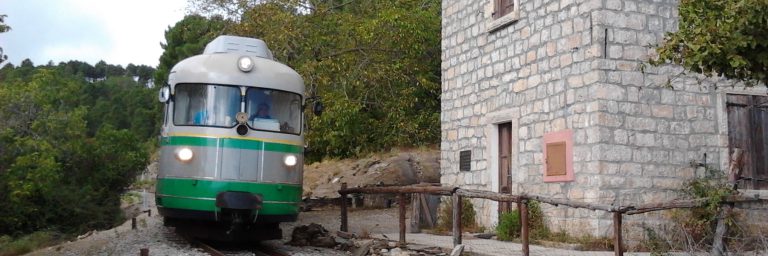One of the best ways to traverse and get to know all the different aspects of the countryside of the island, especially the inner part, is by travelling on the Little Green Train . The train crosses a territory rich in vegetation where the railway line, the bridges, the stations and the roadmen’s houses seem to have always been a part of the landscape, perfectly inserted in an environmental context, sometimes reachable only by train.
And the train moves at the perfect speed, giving the passenger the best way to observe and become familiar with the countryside , the vegetation, that slowly changes as you proceed along the line.
Arbatax Line. Mandas
It is the longest touristic railway line in Italy : 159 km between the Mandas station and the Arbatax station in the seaside pier.
It is also the most frequently used railway line by tourists, and that which named this tourist service, because it crosses (together with the line from Isili to Sorgono) the forests of the most renowned mountains of the island: the Gennargentu range.
The first part of the journey covers a wooded landscape, where the train turns and turns again without reference points. And here, first, is the station of Orroli, the departure base for visiting the neighbouring Nuraghe Arribiu, and after this, Nurri, from where one can easily reach the Flumendosa lake.
The train then plunges into the valley of Garullo , and reaches the quaint and isolated station of Villanovatulo, a few kilometres from the town. The scenery changes abruptly: here you will find the Flumendosa Lake which is crossed by way of a long bridge parallel to the roadway. We have left Sarcidano and we find ourselves in Barbagia di Seulo. The train climbs up a slope for a long ascent, leaving travellers with stunning images of the lake below. Then, set between two tunnels, here is the roadman’s house of Palarana (No. 73), called “punishment” because it was intended for the less disciplined road operators. From here, from a panoramic terrace opens another evocative vista of the underlying valley. Shortly after, you arrive at the delightful mountain stop of Betilli, in the middle of lush flora and in front of the imposing Monte Santa Vittoria, in the territory of Esterzili, whose station is reached after an unusual turn, which is necessary to traverse the steep slope.
The landscape changes again: the train proceeds through the sparsest vegetation of the Sadali plateau, up to the village station, which is shared with Seulo, a few kilometres away. It is one of the most requested arrival points: Sadali offers tourists a good welcome, between the beauty of the territory and excellent cuisine. Continuing uphill, you travel more than 800 metres altitude towards Seui, not before having reached another very important stop, near the old anthracite coal mine of San Sebastiano. The Seui station is amongst the most important of the line, and constitutes another popular travel destination.
From here begins the section that was perhaps the most demanding for the constructors of the railway : you remain at 800 metres altitude, through the mountains of Gennargentu, which are passed by way of long tunnels and bold bridges, among which is the imposing Rio San Gerolamo bridge, consisting of 50 metre long metal girders suspended at a height of 40 metres. Here you find another interesting stop for mountain lovers, in the Ussassai territory of Niala. You proceed at high altitude in the thickest vegetation and pass through another region: the Ogliastra.
The first station is that of Ussassai, a few kilometres from the village, and then the station of Gairo, which is reached after passing through the lunar landscape of the valley of Taquisara. From here another line used to depart, in the direction of Jerzu, which was dismantled in 1956. Passing through other tunnels, you arrive for the second time at the Flumendosa river, near the Villagrande station and the river’s Lago Alto (Upper Lake). Proceeding to the side of the Rio Siccaderba you reach the station of Arzana, and here, in the distance, you can see the sea and the splendid, expansive panorama of the coast of Ogliastra. Descending steeply after the stretch of Pitzu and Cuccu, where the line passes under itself, you arrive at another important station: Lanusei.
Still descending, you cross Elini, with its charming little stone station in the centre of the village; then, you proceed in the flatlands until Tortolì, and finally arrive at the terminus of Arbatax.
 it
it en
en de
de fr
fr es
es


